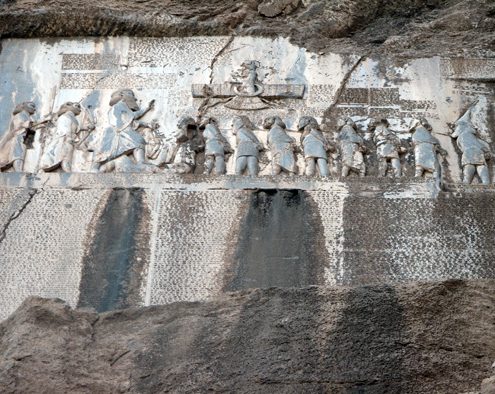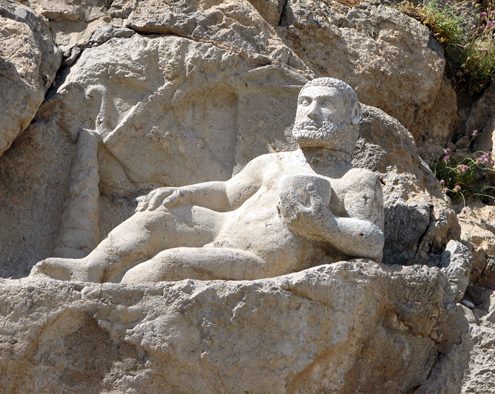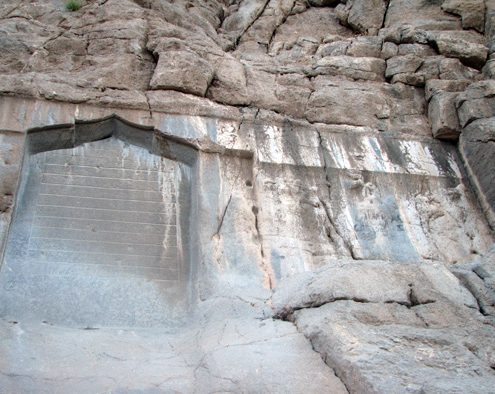Bisotun A World Heritage Site at Western Iran

A closer view of Achaemenian inscription & relief at Bisotun
This ancient archeological site is one of the most outstanding historic attractions of Iran. It has got its name from a relatively perpendicular mount by the same name where it is located. A prehistoric cave called “hunter’s cave” indicates this place has been a human shelter since 40,000 years ago. The ancient trade route between the Mesopotamian and Iranian merchants used to pass by a valley in front of this mount. There are some remnants of Medes, Achaemenians, Sassanians, Ilkhanids and Safavids here that were created several centuries later. I’m going to introduce them at this post:
Bas Relief & Inscription of Darius the Great
After the death of Cyrus the Great, the founder of Persian Empire and Achaemenian dynasty, there was a chaotic situation across the empire about who was his son to ascend the throne. At such crucial time, a few people falsely introduced themselves as Cambyses, his son. When Darius I and other Achaemenian nobles realized the pretenders’ plots, they decided to stop them, save the country and bring law and order back to the nation. Therefore, in a period of approximately less than 2 years, he suppressed these liars and ordered the truth to be written on parchment and potsherd to be distributed everywhere and carved on the face of the mount Bisotun.
This large cuneiform inscription carved on mount Bisotun is the world’s largest inscription ordered by Darius the Great to be inscribed at this site. It explains what the true identity of these people were, where they had come from, who they had pretended to be and how they were arrested. The bas relief also illustrates the story in a scene in which 9 rebels are tied to one another in a row and a magus, the priest, called Gaumata under Darius’ foot.
The decipherment of Bisotun inscription largely contributed to the understanding of cuneiform as well as understanding of ancient civilizations. In this sense, it can be compared to Rosseta Stone in Egypt.
Other Historic Monuments in Bisotun Area
The most significant monuments and historic remnants are:
- Hunters’ cave: a cave from Neandertals’ time, app 40,000 years ago,
- Median remnants: a fortress going back to 8th/7th century B.C on the slope of the mount near the inscription, a Median terrace below the relief of Darius most probably for the worship of an image,
- Achaemenians’ remnants: a royal road built at the time of Darius the Great extended from Susa to Sardis passing by this area,
- Seleucid remnants: a statue of Herakles with a curly hair lying in front of an olive tree,

Statue of Herakles Recumbent at Bisotun
- Parthian remnants: it includes the remnants of Parthian town, bas relief of Gotarzes II and bas relief of Mithridates II, a site of worship, relief of king Balash, etc,

Mithridates relief & Zanganeh Endowment Inscription at Bisotun
- Sassanian remnants: Behistun Palace, which is said to be Palace of Khosrau II, carved stones, Farhad Tarash (a rectangular area of the foothill cut perpendicularly most probably to form some bas relief, but not completed).
- lkhanid caravansery: the rocks, bricks and mortars in form of semi-standing walls and vaults down the slope from the mount and close to the inscription.
- Safavid remnants: a caravansary still standing in the area at a walking distance from the inscriptions, inscription of Sheikh Ali khan Zangeneh, which is a text endowment.

A general view of the remnants of Ilkhanids & Safavids’ caravansaries
